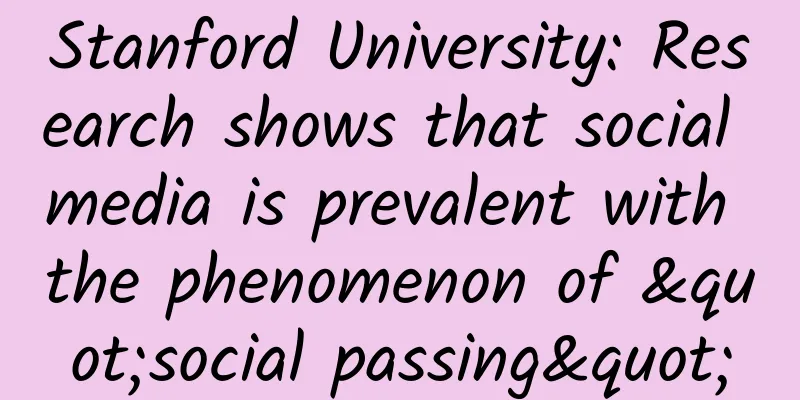Stanford University: Research shows that social media is prevalent with the phenomenon of "social passing"

|
A study conducted by Stanford University and Facebook's data team recently pointed out that the phenomenon of "social passers-by" with "many spectators and few feedback" is common on social media and is seriously underestimated. Most social media also deliberately do not let users know this "cruel" truth, which is also to avoid hurting the social philosophy they insist on. Well, there are also adventurers. In March of this year, Sina Weibo began to display the number of times a user's single Weibo post was read in order to show its presence. The huge contrast between the number of readings and interactive feedback ("likes", comments and reposts) has confirmed the fact that its activity has declined. To some extent, if "social pretense" is whitewashing the superficial prosperity of "broadcast-style" social media such as Weibo and even Facebook, then the "social passerby" phenomenon is constantly puncturing this "prosperity". Social media lacking interactive feedback will ultimately be difficult to sustain, and mobile social tools with strong interactive feedback are already rewriting the landscape. “Social passing” is serious The study on the "social passerby" phenomenon was conducted by Michael S. Bernstein, an assistant professor of computer science at Stanford University, in collaboration with Facebook's data science team. They analyzed 220,000 users whose posts were visible only to friends over a one-month period and found that each of their posts could be seen by 35% of their friends, and their posts each month could be seen by 61% of their friends. However, when they investigated the subjective feelings of more than 500 users about the number of viewers of their posts, they found that these users believed that a particular post of theirs was only seen by 6% of their friends, and their posts each month could only be seen by less than 20% of their friends. In other words, there is a several-fold difference between the user's subjective feelings and the actual number of viewers of the post. Additionally, 21% of Facebook users surveyed said that the number of "likes" and comments influences their subjective perception of the number of viewers. While these responses do not reflect the actual number of viewers, a post that receives no feedback may be disappointing to users. So why are they so quick to underestimate the number of viewers? A Stanford University study pointed out that one reason people underestimate the number of viewers on social media may be to reduce the psychological imbalance. Instead of thinking that many people have seen a post but no one likes it, it is better to think that no one has seen it at all. This may make people feel better. Social media deliberately hides the truth The report also points out that a certain degree of opacity and plausible deniability in social media also has its benefits. In addition to helping sharers maintain psychological balance, it can also help viewers who are unwilling to admit that they have read certain posts to "go invisible." When you post on a social network, it's like being behind a curtain and showing people a slideshow. You know who's invited to the screening, but you can't see who's actually in the room watching. Companies like Facebook, Instagram, and Twitter know that speaking to a room full of friends and family and being ignored is more hurtful than speaking to an empty room, so they don't want users to know this "hard truth." Bernstein believes that "fear of rejection" is just one of the potential reasons why we underestimate the number of social media viewers, and there are many more questions we need to think about. "When I post something, will people not respond but actually like it? Or, will their non-response be out of disgust? Will they block me?" Interactive feedback is more important Therefore, interactive feedback becomes extremely valuable, especially for mobile social tools. Only by adhering to this social concept can we compete with broadcast-style social media in the mobile Internet era and change the landscape. This is why instant messaging applications (IM) have been able to last and become even more popular nowadays. WeChat, WhatWhat's App, and Line, which have quickly accumulated hundreds of millions of users, are considered to be the forces that can subvert Facebook. Have you noticed that "typing" has also become a phenomenal feature that users are looking forward to. There are many other examples, such as services like iMessage that inform users that their messages have been delivered, and the driving force behind the popularity of new services like Snapchat (which have a small audience but very fast feedback). Compared with the above-mentioned services that are good at stimulating feedback, the "broadcast-style" social media with serious "social pass-by" phenomenon may make many people feel that it is not powerful enough, and it faces a great risk of being disrupted in the future. |
<<: Distimo: Report shows that 91% of the world's top 100 companies have released mobile apps
Recommend
Can women do push-ups to help them lose weight?
Now with the improvement of living standards, man...
The following are some of the appearances of women
Judging the strength of a woman's sexual desi...
Should dried radish be pickled or dried in the sun first? How to dry dried radish to make it taste best
Dried radish is fresh radish dried in the sun, a ...
How to solve vulvar itching?
I believe that many female friends will encounter...
What is the cause of yellow blood in leucorrhea?
When women have abnormal leucorrhea, they should ...
How to improve kidney deficiency in women
When it comes to kidney deficiency, many friends ...
When is the graduation banquet usually held? How to write an invitation to the graduation banquet
The graduation banquet, also known as the teacher...
How many days do I need to rest after a painless abortion?
Painless abortion is a common method of abortion....
Can urine test detect pregnancy?
Many people often find out they are pregnant when...
Blood only comes out when you urinate during menstruation
Menstruation is a symbol of female friends, becau...
What happens if a woman has her uterus removed?
Many women need to have their uterus removed afte...
When is the best time to take Pueraria powder for breast enhancement?
Pueraria powder is a common food in daily life. I...
There is a "silent killer" lurking around us
News background: Osteoporotic vertebral compressi...
Intestinal flora and tumors: a game in the microscopic world
Author: Wang Yu, attending physician of Changzhi ...
The body is getting old quietly, these signs remind you to start anti-aging
Everyone will experience aging, and the most obvi...









